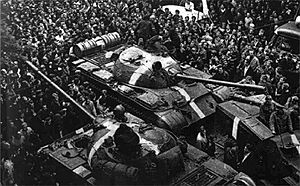Prague Spring facts for kids
The Prague Spring was a time in 1968 when Alexander Dubček, a leader of Czechoslovakia's Communist Party, tried to make the country more free and democratic. However, the Soviet Union worried that Czechoslovakia was moving too far from communist ideas. Because of this, countries from the Warsaw Pact (a military alliance led by the Soviet Union) invaded Czechoslovakia on August 20-21, 1968. Right after the invasion, many people protested across Czechoslovakia.
The Prague Spring was an attempt to create a special kind of socialism – one that was more fair and free for people. This happened in Eastern Europe after World War II. However, this effort was stopped by force from the Warsaw Pact countries on August 21, 1968. This event was one of many protests and conflicts that happened during the Cold War. Other examples include protests in France in May 1968, student protests against the Vietnam War, and the rule by a military government in Greece (1967-1974).
After the invasion, most of the changes made during the Prague Spring were undone or stopped. This period after the Prague Spring is known as "normalization." The only major change that remained was the federalization of Czechoslovakia. Czechoslovakia officially became a federal country on January 1, 1969.
Images for kids
-
Main leaders of the Prague Spring in 1968 (from left to right): Oldřich Černík, Alexander Dubček, Ludvík Svoboda, and Josef Smrkovský.
-
Romanian Prime Secretary Nicolae Ceauşescu gives a speech criticizing the invasion, in front of a crowd in Bucharest, August 21, 1968.
See also
 In Spanish: Primavera de Praga para niños
In Spanish: Primavera de Praga para niños







